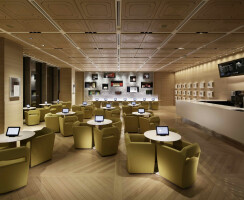Paper, originally conceived in ancient China, found its way to Japan around the 7th century. There, the material was perfected into the unique and indigenous genus of traditional washi (Japanese paper). It is believed that papermaking techniques arrived in Europe sometime around the 12th century, in connection with papermaking artisans being taken prisoner in wars waged between Asia and the Middle East and the Middle East and Europe. Western-style paper came into use throughout Europe around the 15th century, with sheepskin (parchment) utilized in such a capacity up to that time.
Around the same time, letterpress-style printing was invented by Johannes Gutenberg, leading to the legendary Gutenberg Bible being printed on a mix of paper and parchment. The honto CAFE, which exhibits a replica of that iconic parchment bible, is in fact a showroom operated by Dai Nippon Printing Company (DNP), a printing business launched in the Meiji Era of Japanese history. This cafe provides guests the hybrid experience of digital and printed books.
Located in one corner of the space is a cafe counter serving Fairtrade coffee. The showroom component incorporates wood materials in the floor, walls and ceiling. In its design, the quantity of materials in use is limited to enable guests to more firmly concentrate their attention on the books on display. Each table and desk is outfitted with a tablet terminal, giving guests ready access to their digital books of choice by tapping on the screens. Also including in the planning is space engineered for frontal exhibits of printed books, with efforts made to regularly promote best sellers and other publications that have stirred up a buzz.
Over its decades in the printing business, DNP has also compiled an impressive collection of important written works. To furnish refined display space for these publications, 100,000 fonts were cast in the DNP original typeface known as shueitai. The fonts are arranged in a tile format to form a masonry style soldered wall. Mounted in the wall surface are glass covered pictorial displays tooled to showcase the precious pieces in the DNP collection.





























